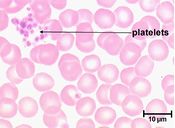Platelet Abnormalities
Introduction
Platelets (or thrombocytes) are responsible for primary haemostasis by the formation of a temporary platelet plug that initially seals any breach to a blood vessel wall. These breaches are then sealed more completely by the formation of a fibrin clot induced by the coagulation factor cascade.
Terminology
- Thrombocytopaenia refers to low absolute numbers of platelets. Immune-mediated thrombocytopaenia (ITP) is one common cause of thrombocytopaenia and this may be a primary or secondary disease.
- Thrombocytopathia refers to platelets that are unable to function adequately.
- Thrombocytosis refers to an increase in the blood platelet concentration above the normal level.
Thrombocytopaenia and thrombocytopathia lead to disorders of primary haemostasis but, in general, this is less serious than the disorders of secondary haemostasis caused by deficiencies in the coagulation factors.
Thrombocytopaenia
Thrombocytopaenia is a common haematological abnormality as platelet numbers are subject to fluctuation in a number of diseases. Care should be taken, however to ensure that this finding is not caused by an artefact of sampling where platelet clumps have formed. The normal blood platelet concentration of the dog is 175-500x10^9 but clinical disease is not usually observed until this level falls below 50x10^9 and spontaneous haemorrhage is observed only when the level falls below 20x10^9. Reductions in platelet numbers may be caused by a failure to produce adequate amounts in the bone marrow during megakaryopoiesis, or an increased destruction of existing platelets or sequestration of platelets outside of the circulation.
Diseases that cause bone marrow suppression include:
- Aplastic anaemia which can be caused by the ingestion of bracken or administration of oestrogens, chloramphenicol or sulphonamide antibiotics. Prolonged use of phenylbutazone or salicylates may cause the same disease.
- Infectious diseases that reduce stem cell function include canine distemper, canine parvovirus and feline panleucopaenia virus.
- Myelophthisis is the displacement of the normal cell lines of the bone marrow by another cell or tissue type which may also reduce the function of the megakaryocytes. Diseases in this category include myelofibrosis and immunoproliferative or myeloproliferative neoplastic disease.
- Radiotherapy or myelosuppressive chemotherapy may cause reversible bone marrow suppression.
Diseases that cause increased destruction of platelets
- Immune-mediated thrombocytopaenia is a common autoimmune disease that leads to the production of antibodies against platelets and their subsequent destruction by cells of the monocyte phagocyte system (MPS).
- Infectious diseases that cause destruction of platelets include bovine viral diarrhoea (BVD), classical swine fever and infectious canine hepatitis. The parasites Anaplasma platys, Anaplasma phagocytophilum and ''Ehrlichia canis'' may also cause infectious thrombocytopaenia. Any severe bacterial infection, including those caused by Staphylococci and the Gram negative bacteria that produce endotoxins (e.g. Pseudomonas spp. or Salmonella spp.) may also result in the destruction of platelets.
Diseases that cause sequestration of platelets usually involve some enlargement of the spleen, as this is the major organ where platelets are stored outside of the circulation. A common example would be haemangiosarcoma of the spleen and liver. Splenic enlargement under general anaesthesia maintained with agents such as barbiturates and phenothiazines can also lead to sequestration of platelets.
Artefactual or spurious thrombocytopaenia
- Cavalier King Charles spaniels have a relatively small number of giant platelets (macrothrombocytes) but they do not suffer from bleeding disorders as they maintain a similar total platelet mass as do dogs of other breeds.
- If venepuncture is traumatic, platelet clumps may form and these will not be counted by automated machines. The presence of clumps can be investigated by making a blood smear and examining the feathered edge for large agglomerations of platelets.
Thrombocytopathia
Defects in platelet function may be congenital defects or they may be acquired with a number of diseases. Congenital thrombocytopathias are rare inherited diseases which are characterised by defects in platelet adhesiveness, aggregation or factor release. The defects are usually associated with particular breeds, such as Chediak-Higashi syndrome in blue smoke Persian cats.
Causes of acquired thrombocytopathia include:
- Infection with Angiostrongylus vasorum, the canine lungworm, which also causes a consumptive coagulopathy.
- Hypergammaglobulinaemia as occurs with multiple myeloma and some forms of (B-cell) lymphoma may affect platelet function.
- Administration of large volumes of some colloid solutions.
- Administration of certain pharmaceutical products, including non-steroidal anti-inflammatory drugs and cephalosporins.
Thrombocytosis
Increases in platelets above the normal level may occur due to physiological or pathological processes.
- Physiological
- Splenic contraction pushes sequestered platelets into the circulation. This phenomenon is especially marked in horses which have a muscular splenic capsule.
- Splenectomy prevents the sequestration of platelets in the spleen, resulting in constantly increased levels of platelets.
- As part of a response to anaemia, a reactive thrombocytosis is often documented and this may precede signs of regeneration.
- Pathological
- Essential thrombocythaemia is a rare myeloproliferative disease that results in the excessive production of platelets which function abnormally. Affected animals suffer from bouts of spontaneous haemorrhage.
Clinical Significance
Other than essential thrombocythaemia, thrombocytosis has no clinical importance except as an indicator of another disease process. Thrombocytopaenia and thrombocytopathia both result in reductions in the effectiveness of primary haemostasis, producing bleeding disorders. Since bleeding points are usually sealed by a fibrin clot, disorders of primary haemostasis tend to be less severe than those caused by deficiencies of the coagulation factors. Common signs of a disorder of primary haemostasis include:
- Petechial or ecchymotic haemorrhages on the skin or mucous membranes.
- Haemorrhages from the mucous membranes, producing haematuria, haematochezia, haematemesis, haemoptysis and melaena.
- Anaemia with reactive neutrophilia and monocytosis if the haemorrhage is severe.
Severe platelet deficiencies may be managed with transfusions of whole blood or, in the USA, with transfusions of platelet cryoprecipitate. With both techniques however, it is likely that the transfused platelets have only a short half life in the recipient.
The use of vincristine (a drug also used in chemotherapy for neoplasia) has been advocated in cases of thrombocytopaenia as it causes the release of immature platelets from the bone marrow.
